Text

"Haniwa and Earthenware (J)" [ハニワと土器 (J)] by Saitō Kiyoshi (斎藤清), 1952
"Haniwa y loza (J)" de Saitō Kiyoshi, 1952
From the collection of the Kiyoshi Saito Museum of Art in Yanaizu City, Fukushima Prefecture
#japanese art#arte japonés#斎藤清#saito kiyoshi#埴輪#haniwa#創作版画#sosaku hanga#japanese p#japanese prints#impresiones japonesas#wood#woodblock print#grabado en madera
12 notes
·
View notes
Text
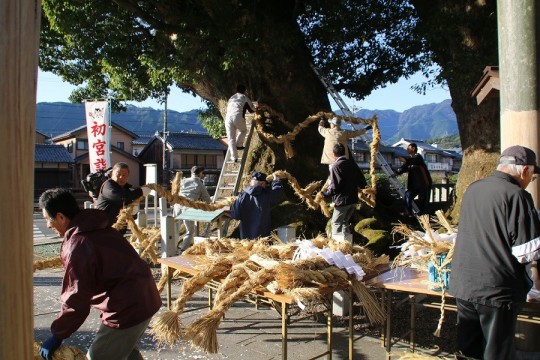
Parishioners working to hang shimenawa straw ropes around the sacred husband & wife camphor tree (夫婦楠) just inside the entrance to Owase Jinja Shrine (尾鷲神社) in Owase, Mie Prefecture during the Ōkusu Shimenawa-kake Shinji ritual (大楠注連縄掛神事) held on the fourth day of June and December
Image from the shrine's official website
26 notes
·
View notes
Text

Shura (修羅) by Yamaguchi Mio (山口美音), 2020
From the special exhibition "Radical Clay: Contemporary Women Artists from Japan" (Dec 16, 2023–Jun 3, 2024) at the Art Institute of Chicago
#japanese art#arte japonés#山口美音#yamaguchi mio#women artists#mujeres artistas#ceramic art#arte ceramico#art institute of chicago#instituto de arte de chicago
61 notes
·
View notes
Text

A photographic portrait of the author Abe Kōbō (安部公房) (1924-1993) in 1956
Un retrato fotográfico del autor Abe Kōbō (安部公房) (1924-1993) en 1956
11 notes
·
View notes
Text

A lively moment in the Procession of Servants (奴行列), part of the Flower Offering Ceremonies (花供会式) in which cherry blossoms are offered up to the shrine of the deity Zao Gongen (蔵王権現) in Yoshino, Nara Prefecture
Un momento animado en la Procesión de los Siervos (奴行列), parte de las Ceremonias de Ofrenda Floral (花供会式) en las que se ofrecen flores de cerezo al santuario de la deidad Zao Gongen (蔵王権現) en el pueblo de Yoshino, Prefectura de Nara
Photo from a 1985 publication, image from the photography collection of the Nara Prefectural Library
22 notes
·
View notes
Photo
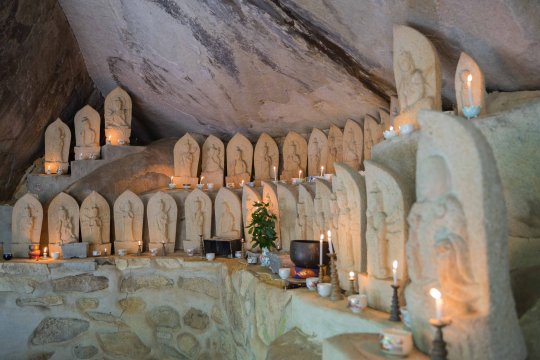
The Grotto Hall Files
Several entries from the journal I kept during my days living in southern Mie Prefecture regarding the Iwayadō Hall (岩屋堂) in the foothills of Mount Tengura (天狗倉山) in Owase, Mie Prefecture
[Image from Owase’s official twitter account (c.f. source below)]
September 3, 1995
Today I was up in the area around 天狗倉山 [Mount Tengura], and I finally found the elusive 岩屋堂 [Iwayadō Hall], luckily enough. The entrance is small, and one walks up an old stone stepway ducking to avoid the branches of trees. The path widens a bit, and skirts the mountain, and is on the steep side here and there, but it’s a pleasant atmosphere overall. Following the forested path and passing stones on the curving walkway, finally one arrives at the 岩屋堂 [Iwayadō Hall], which true to its name is based around and under a huge rock. At one side is a small graveyard, including a grave to a 平家 [Heike] person (?). On the other side are some unusual miniature shrines, including one to 大海龍王 白蛇明神 [Dragon King of the Great Sea, White Snake Shining Deity].
But the main attraction was the collection of stone statues under the rock, most of whom were 観音菩薩 [Kannon Bodhisattva] and made sometime towards the end of the Kamakura Period [correction: the main image enshrined & hidden dates to this time (1185-1333) but the smaller stone images visible probably date considerably later to the 1600′s or so]. They’re based upon the 33ヶ所 of 観音 [the Western Pilgrimage Circuit of Thirty-three Kannon Temples], and pilgrims would stop here on their way to the first stop in the pilgrimage, down south in the 熊野 [Kumano] region. Also some more recent ones, 地蔵菩薩 [Jizō Bodhisattva] for the souls of the victims of the big tsunami that hit this area in the Edo Period [1707 to be exact].
You could almost feel the worship of countless folks, the history of Buddhism as it spread among everyday people—which, considering I was sweaty & exhausted from the trek, I’m surprised I felt anything.
September 8, 1995
Today at the language lesson with [a friend], I got some good information about last Sunday’s 岩屋堂 [Iwayadō Hall]. For instance, the 白蛇明神 [White Snake Shining Deity]: she wasn’t sure, but often snakes are worshipped as 神 [deities], and especially unusual or large ones are regarded as a good sign. Such snakes or the like are worshipped for the usual kind of thing like prosperity of the household or such. Eggs are the offering. A related sort of folk custom: if you find a discarded snakeskin, put it in your wallet and your money will increase.
On the way is a rock shaped like a turtle staring down people on the path, and some people can’t proceed under this stern (stony?) glare. To be able to pass is a signal that you’re pure. I didn’t even notice, so either I’m really cool or maybe just selectively oblivious.
The graveyard could indeed be the final resting place of Heike refugees, she confirmed.
Inside the main place with the 石仏 [stone statues of Buddhist deities] is a stone called the おもかるいし = 重軽石 [heavy/light stone]. Think of a question in your life, ask it, and try to lift the stone. If you can lift it easily, the answer is yes; if it’s so heavy you can’t lift it, the answer is no. She doesn’t usually go in for such old tales wholesale, but this one’s really mysterious, according to her. For instance. her younger sister asked the rock whether getting married was the right idea a short time before the actual wedding. Pretty risky question, kind of awkward if the stone had turned heavy. Luckily it was light as a feather.
She knows the place pretty well, because there’s a 命日 [anniversary rite] there every 18th day of the month from around 10:00 AM or so, where goma ceremonies and such are performed. Her neighborhood machi is especially associated in some way.
November 18, 1995
I woke up a bit early and met [my friend’s mother], and we went up to the 岩屋堂 [Iwayadō Hall] together with a friend of hers. [my friend] was busy, and her grandmother had a cold, so they couldn’t make it.
The monk, a smallish guy with a slow & deliberate manner of speech, comes from 新宮 [Shingū] every 18th of the month to perform this 護摩 [goma fire rite] ceremony. On the 護摩木 [goma kindling stick] was written the more elaborate “kanman” 梵字 [Sanskrit syllable] for 不動明王 [Fudō Myōō], not too unexpectedly.
Chanted during the ceremony was the opening stuff, the 般若心經 [Heart Sutra], the 觀音經 [Kannon Sutra], and the धारणी [dhāraṇī] of 不動明王, 観音菩薩, 地蔵菩薩, & 薬師如来 [Fudō Myōō, Kannon Bodhisattva, Jizō Bodhisattva, and Yakushi Buddha]. They chant all of this super fast and then without taking a breath cycle back to the beginning over and over again, making it rather hard to follow along. Here at the 岩屋堂 [Iwayadō Hall] are the 33 観音 [Kannon] and the tsunami 地蔵 [Jizō] so chanting them made sense, but I was a bit fuzzy about the inclusion of the other two. Afterwards, when I asked about this, statues of them were pointed out to me–their non-standard iconography had stumped me, apparently: 不動 [Fudō] with a weird abstract face & 薬師 [Yakushi] with a hood and looking like a normal guy rather than a Buddha.
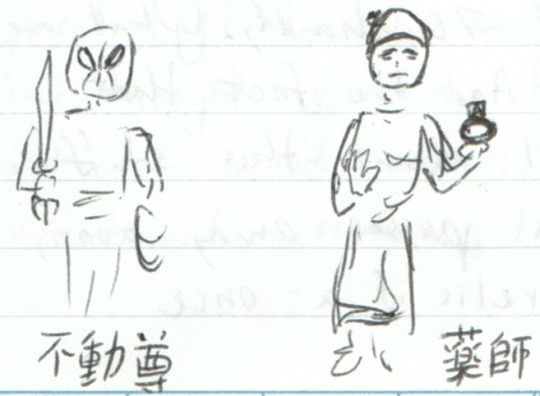
During the ceremony, a lady waved the food offerings over the 護摩 [goma] fire, very much as if sending them up to 不動 [Fudō] (presumably?) in remarkably Vedic style right here in Japan 1995. Afterwards these offerings were divided up among the participants as お下がり= o-sagari, leftovers from the 神さん [deities]–they have the same habit as the old man at 有久寺 [Arikuji Temple] of referring to any holy being by this term.
Also we were treated to おにぎり[rice balls] and なます [daikon radish & carrot salad], quite good at that, which is referred to as お接待 =o-settai or お志し = o-kokorozashi, food given to pilgrims for their support. Which reminds [my friend’s mother] of customs in Shikoku, she mentioned.
Retrospectively now in March 2021 and in conclusion, many thanks to my friend of the time for putting up with my odd topics of discussion and for going out of her way to arrange for my participation in her neighborhood’s monthly rites with my unaccountable interest in mind, and to my friend’s mother and the other ladies of Asahi-machi for allowing me to tag along and treating me to exemplary pilgrim’s fare on a pleasant & informative Saturday morning.
16 notes
·
View notes
Text
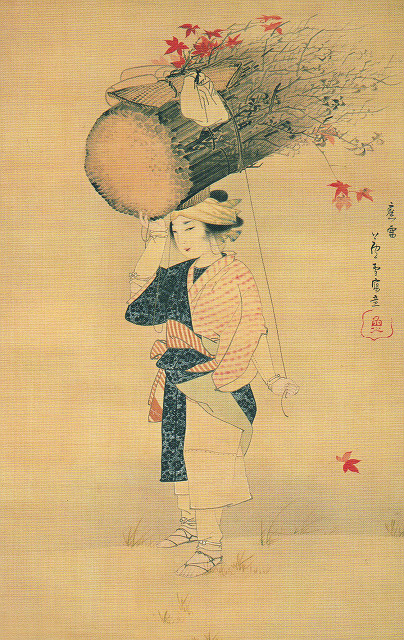
"An Ōhara Girl" (大原女) by Nagasawa Rosetsu (長沢蘆雪) (1754-1799)
32 notes
·
View notes
Text
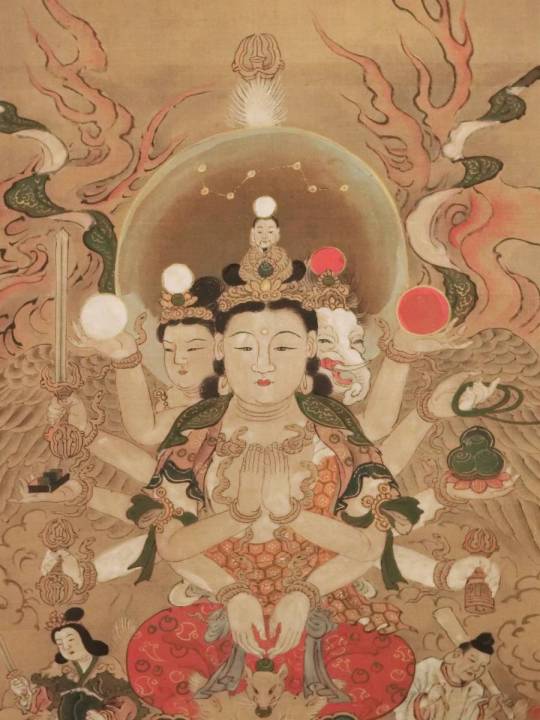
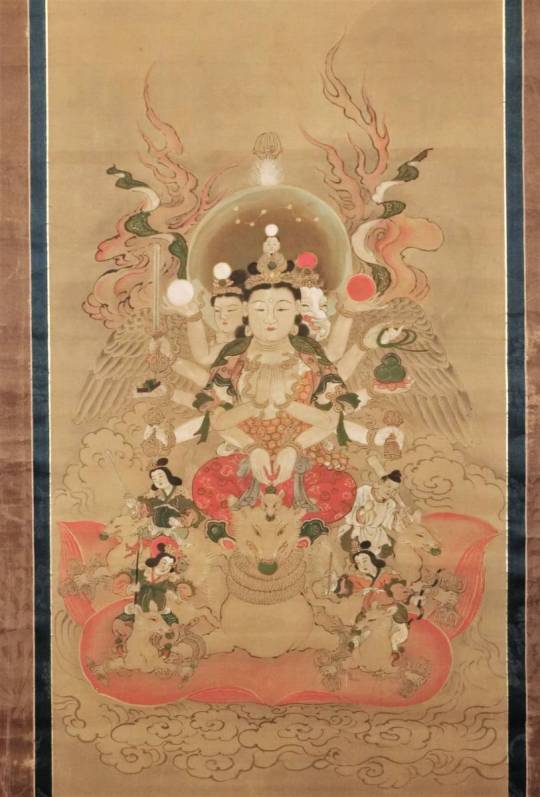
A painted image of the goddess Dakiniten (荼枳尼天), invoked generally for prosperity and fecundity (undated hanging scroll, colors and gold on silk)
Una imagen pintada de la diosa Dakiniten (荼枳尼天), invocada generalmente por la prosperidad y la fecundidad (rollo colgante sin fecha, colores y oro sobre seda)
15 notes
·
View notes
Text

A painted image of the wrathful deity of love and attraction Aizen Myōō (愛染明王) dating to the 12th century (hanging scroll, ink & colors on silk from the collection of the Nara National Museum)
Una imagen pintada de la deidad iracunda del amor y la atracción Aizen Myōō (愛染明王) que data del siglo XII (rollo colgante, tinta y colores sobre seda de la colección del Museo Nacional de Nara)
22 notes
·
View notes
Text

A painted image of the wrathful deity Ususama Myōō (烏枢瑟摩明王) dating to the 14th century (hanging scroll, ink & colors on silk from the collection of the Nara National Museum)
Una imagen pintada de la deidad iracunda Ususama Myōō (烏枢瑟摩明王) que data del siglo XIV (rollo colgante, tinta y colores sobre seda de la colección del Museo Nacional de Nara)
#japanese art#buddhist art#arte japonés#arte budista#烏枢瑟摩明王#ususama myoo#hanging scroll#rollo colgante
21 notes
·
View notes
Photo
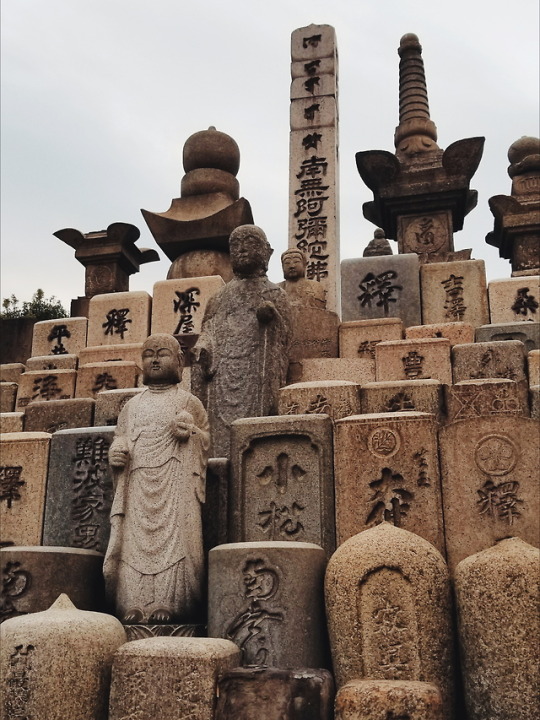
大阪市 天王寺区 四天王寺
826 notes
·
View notes
Text

A painted image of Fugen Bodhisattva (普賢菩薩) together with the Ten Rasetsunyo (十羅刹女), a group of demonesses converted into guardian spirits of the Lotus Sutra (Hanging scroll, ink and colors on silk dating to the 13th century from the collection of the Nara National Museum)
Una imagen pintada del Bodhisattva Fugen (普賢菩薩) junto con las Diez Rasetsunyo (十羅刹女), un grupo de demonias convertidas en espíritus guardianes del Sutra del loto (Rollo colgante, tinta y colores sobre seda que datan del siglo XIII de la colección del Museo Nacional de Nara)
#japanese art#buddhist art#arte japonés#arte budista#普賢菩薩#fugen#十羅刹女#jurasetsunyo#hanging scroll#rollo colgante
19 notes
·
View notes
Text

"Food Offerings" (供饌) by Ishijima Yoshinori (石島良則) (1902-1939)
22 notes
·
View notes
Text

A portrait of the nun Shinnyo (信如) (1211-c. 1282), restorer and abbess of Chūgūji Temple (中宮寺) in present-day Ikaruga, Nara Prefecture
Un retrato de la monja Shinnyo (信如) (1211-c. 1282), restauradora y abadesa del templo Chūgūji (中宮寺) en la actual ciudad de Ikaruga, prefectura de Nara
Image from "Amamonzeki: A Hidden Heritage: Treasures of the Japanese Imperial Convents" published by the Sankei Shimbun, 2009, page 46
#japanese art#buddhist art#arte budista#arte japonés#信如#shinnyo#buddhist nun#monja budista#奈良県#nara prefecture#斑鳩町#ikaruga#中宮寺#chuguji#portrait#retrato#crazyfoxarchives
14 notes
·
View notes
Text

A sculpted image of Senju Kannon Bodhisattva (千手観音菩薩) dating to the 16th century at Jōkyōji Temple (常教寺) in Matsusaka, Mie Prefecture
Una imagen esculpida del Bodhisattva Senju Kannon (千手観音菩薩) que data del siglo XVI en el templo Jōkyōji (常教寺) en la ciudad de Matsusaka, prefectura de Mie
Photo by ぶちゅぞう [Buchuzō], February 24, 2024
#japanese art#buddhist art#arte japonés#arte budista#千手観音菩薩#千手観音#senju kannon#観音菩薩#観音#kannon#三重県#mie prefecture#松阪市#matsusaka#常教寺#jokyoji
29 notes
·
View notes
Photo
A fire prevention poster from Kyoto Prefecture in 1950
Un cartel de prevención de incendios de la prefectura de Kioto en 1950

ななようさんのツイート: “昭和25年の京都府の防火ポスターは最強 https://t.co/36aEBd1zVm”
京都人、容赦ねえ
#京都府#kyoto prefecture#京都#kyoto#graphic design#japanese graphic design#diseño gráfico japonés#kioto#prefectura de kioto#poster art#arte del cartel
689 notes
·
View notes
Text
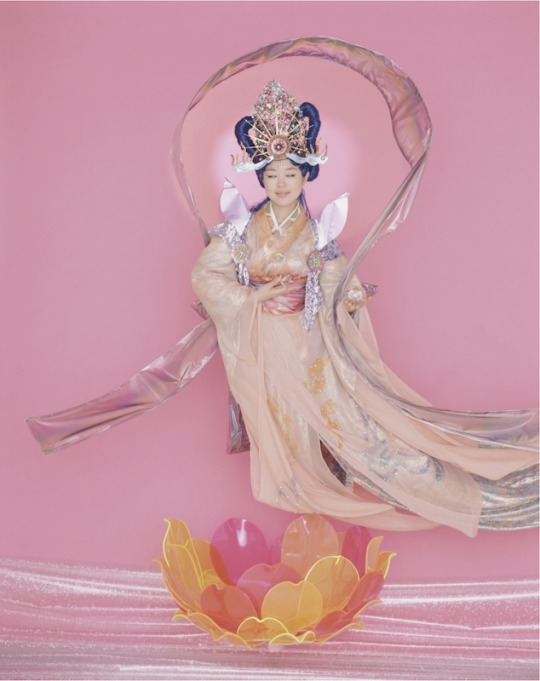
"Nirvana" by Mori Mariko (森万里子), 1997
15 notes
·
View notes